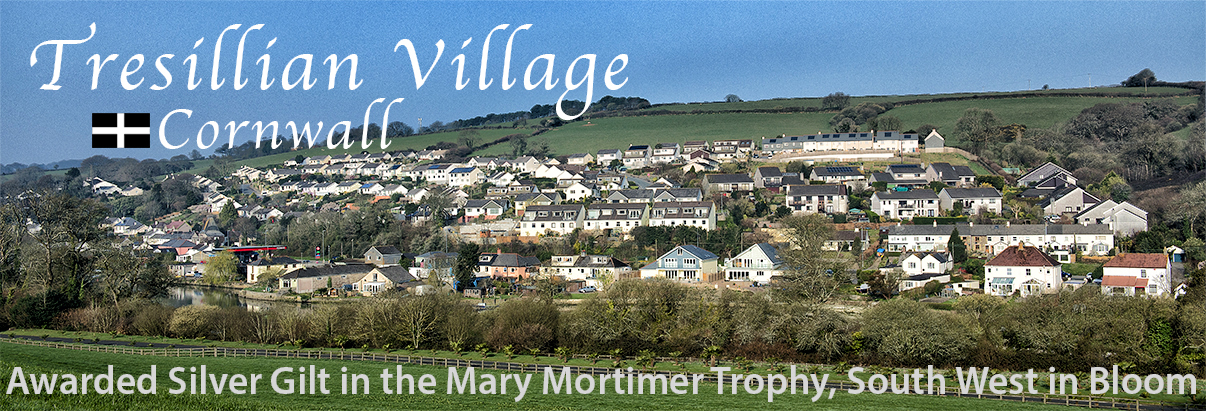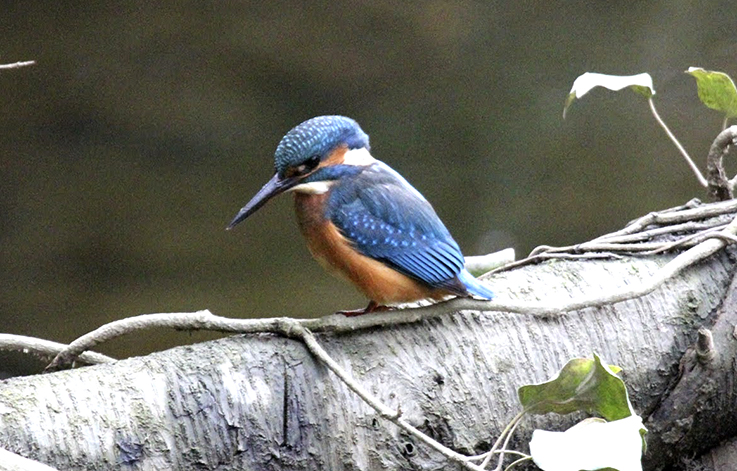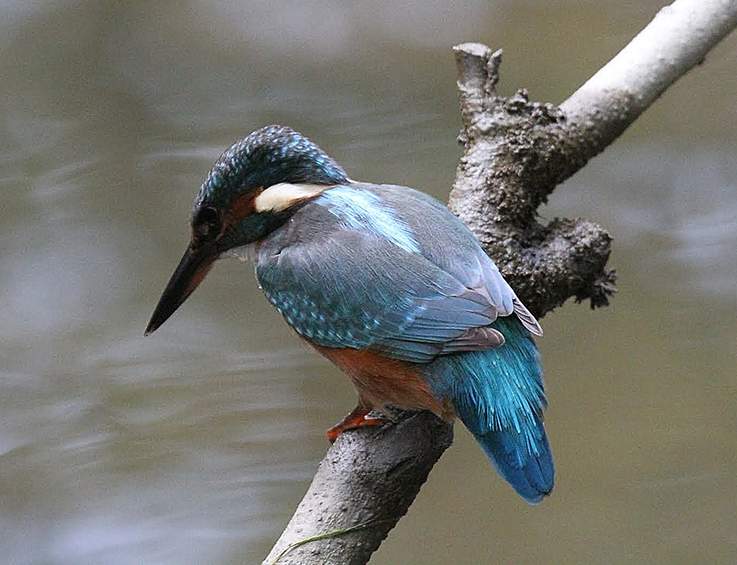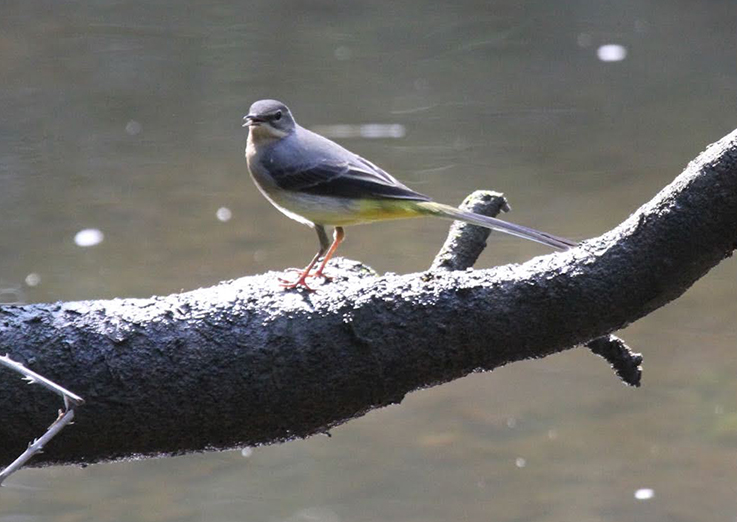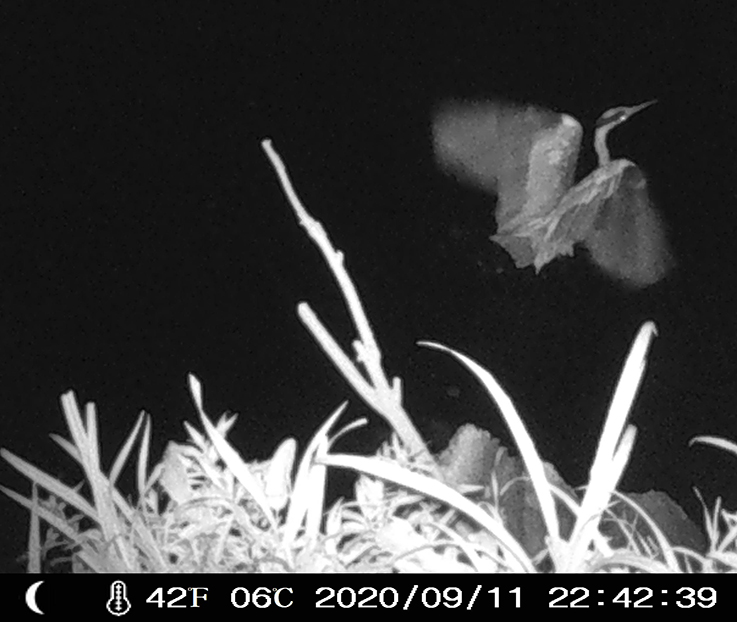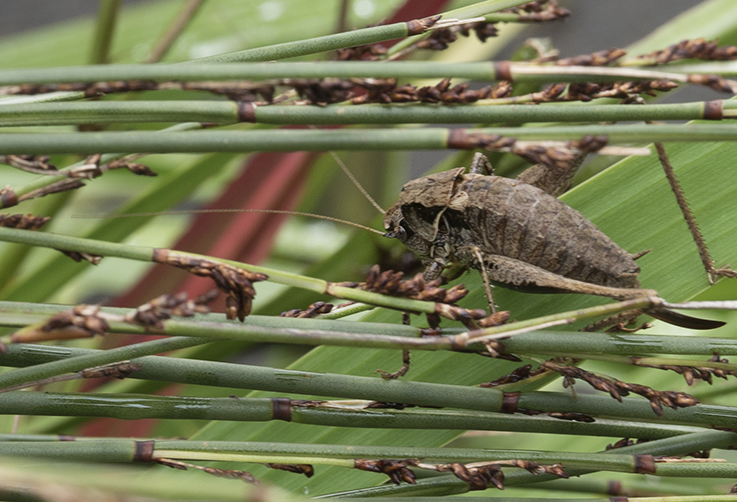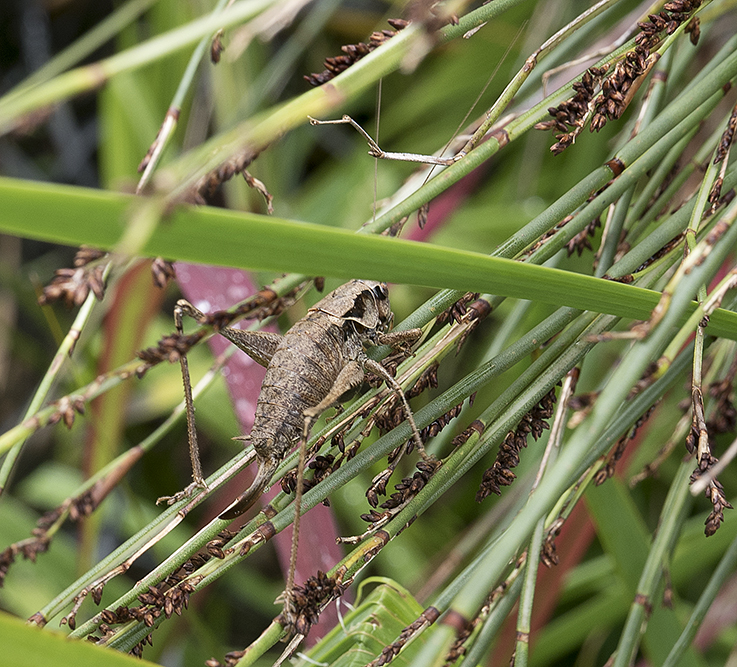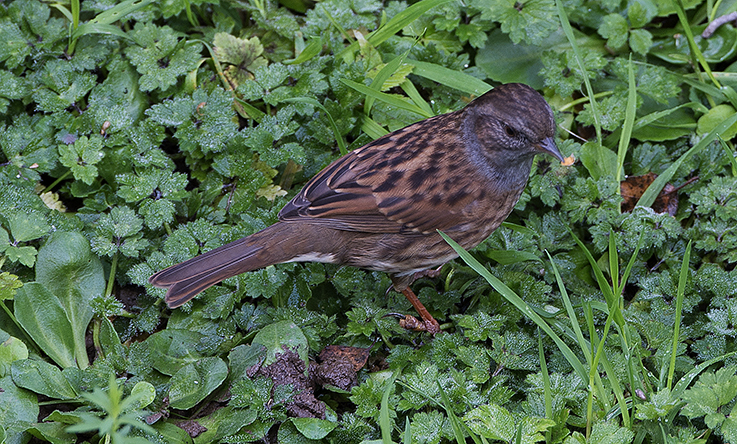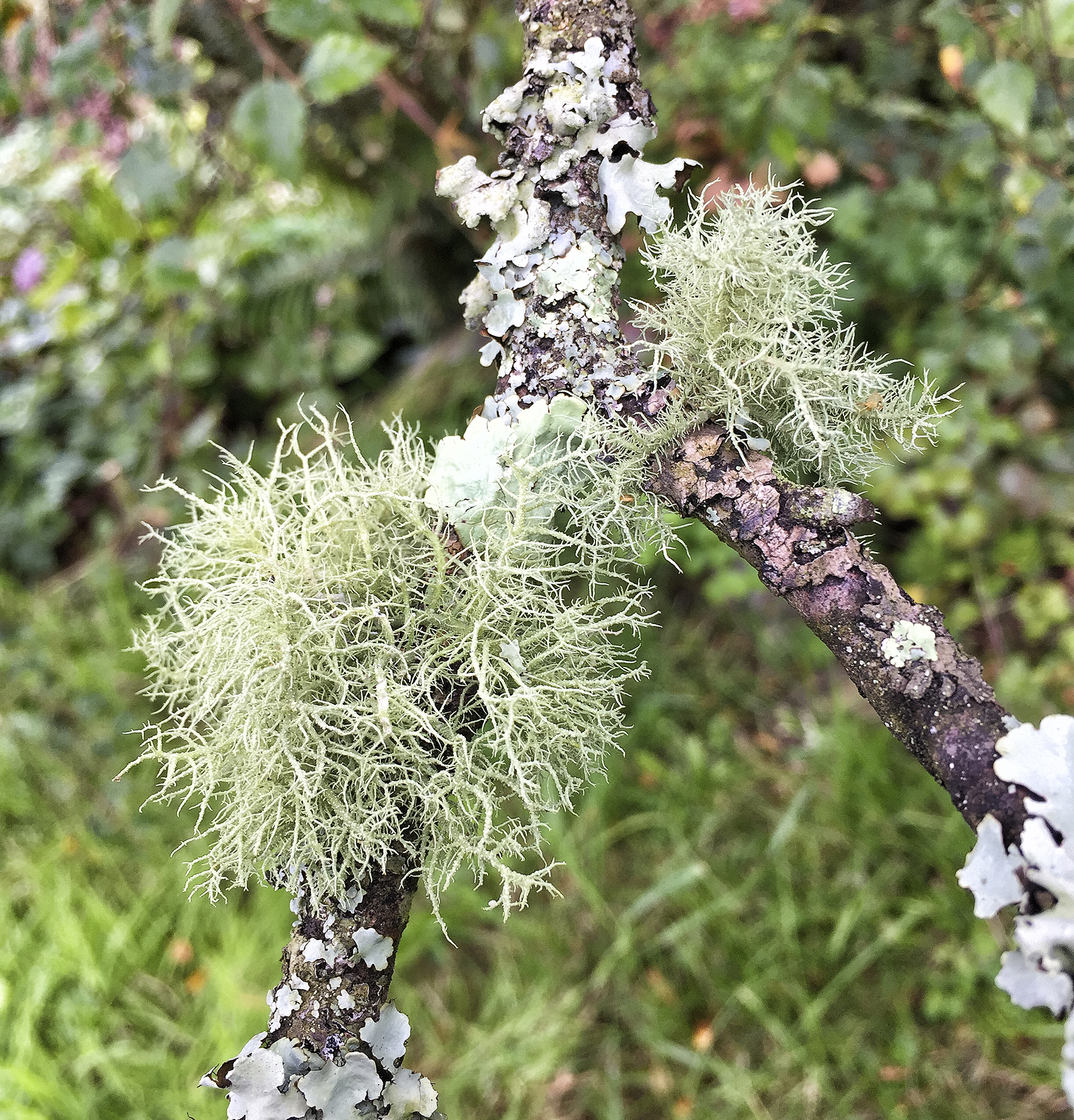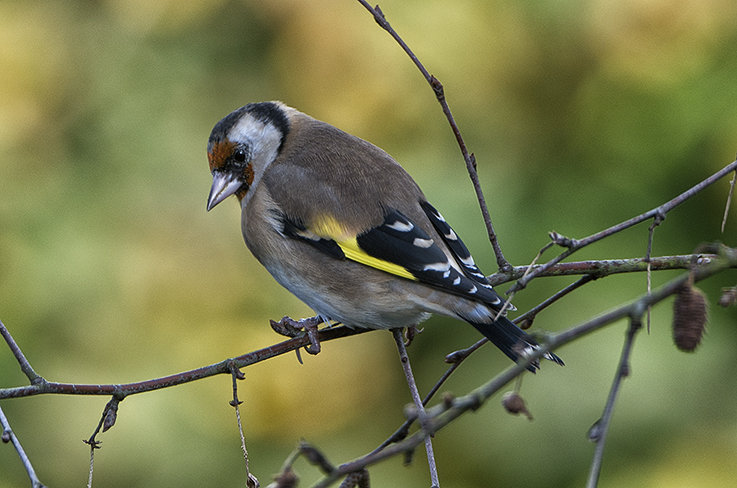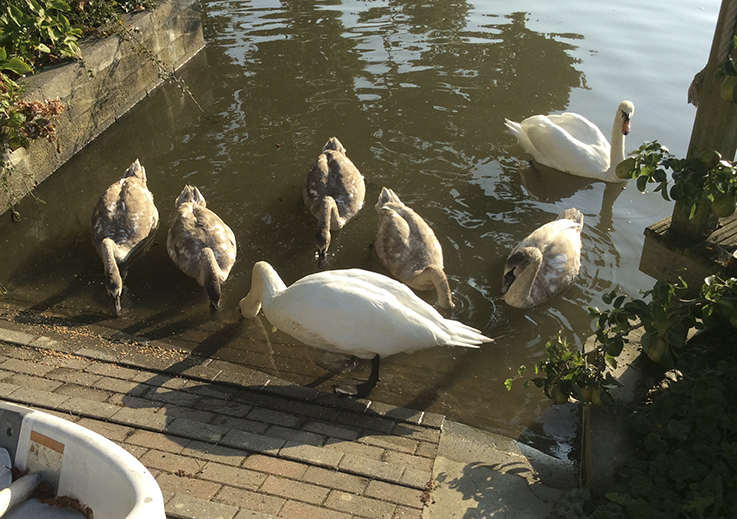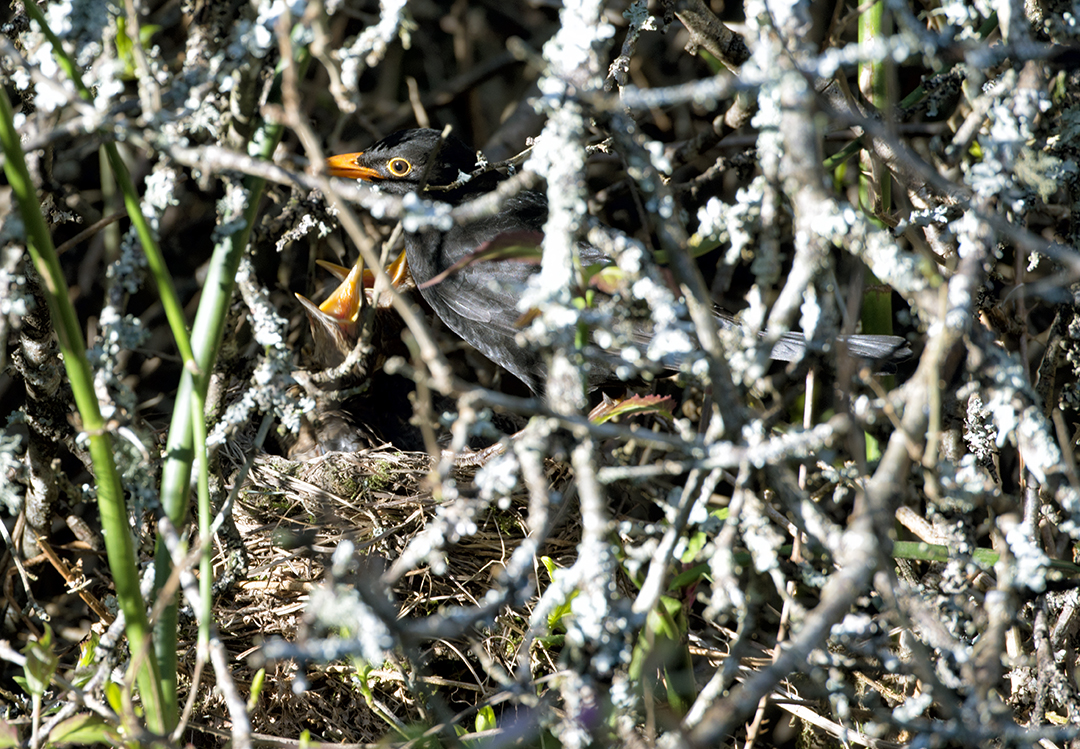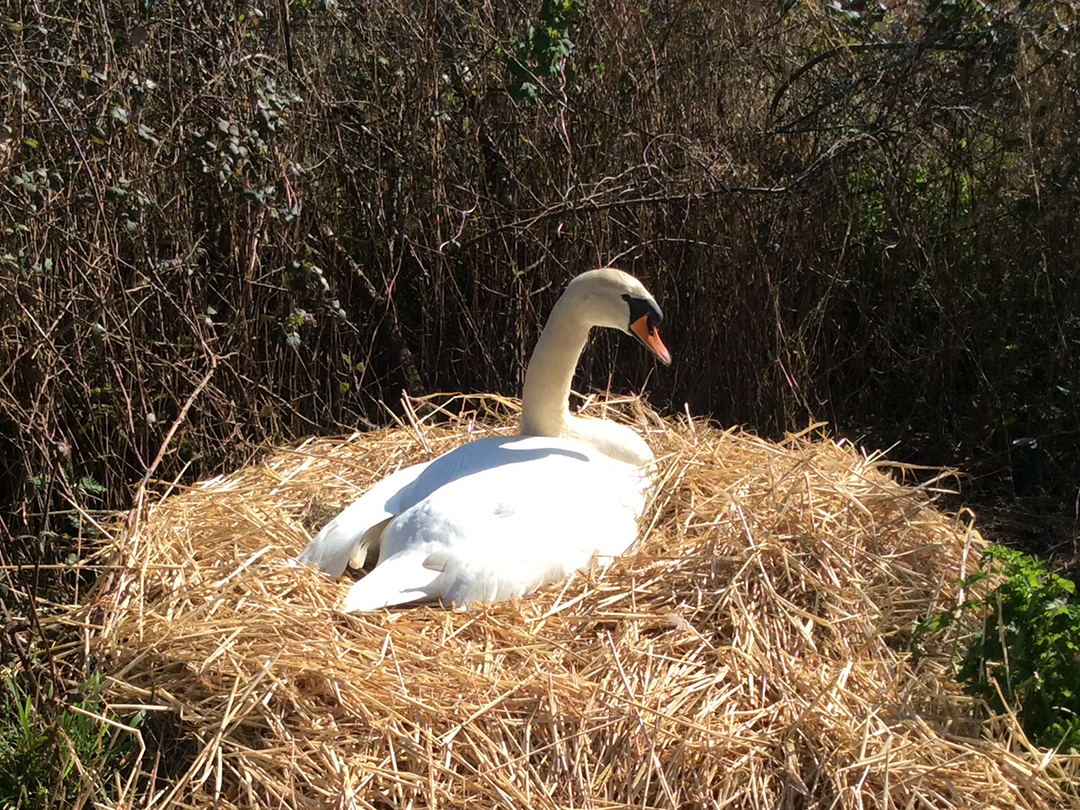11-12-2020 News of the village swans.
The 4 cygnets have now been driven off the upper reaches of the river by their parents as is customary at this time of year, 7 months after hatching. All have done well, and one has returned this morning to try and get another feed, though is not made welcome particularly by the pen. If you see the birds downstream do please try and give them some wholemeal bread or a scoop of corn as they try to adjust to life after ‘home’!
Philip Buddell
November 2020 Andrew Nicholson – Lockdown Birding in Tresillian – Bird’s Eye View.
During this extraordinary and challenging year, many people have found solace in the rhythms of nature. With many restrictions in life, to live somewhere like Tresillian in the heart of the Cornish countryside has been a great relief when in other parts of the country, people spent weeks on end stuck in high rise tower blocks.
At the beginning of the first Lockdown back in March, when all no- essential travel was banned, I decided to keep a list of all the different bird species I saw in and around Tresillian within walking distance. As I write this in late November, the total is now over 80 species. Here are some of the highlights of the last eight months:
Everyone in Tresillian will be familiar with Canada Geese, but we have also been visited by two more unusual Geese species this year. First in March, a Pink Footed Goose was around for a couple of weeks (spending some of its time just over the wall by the Texaco garage),
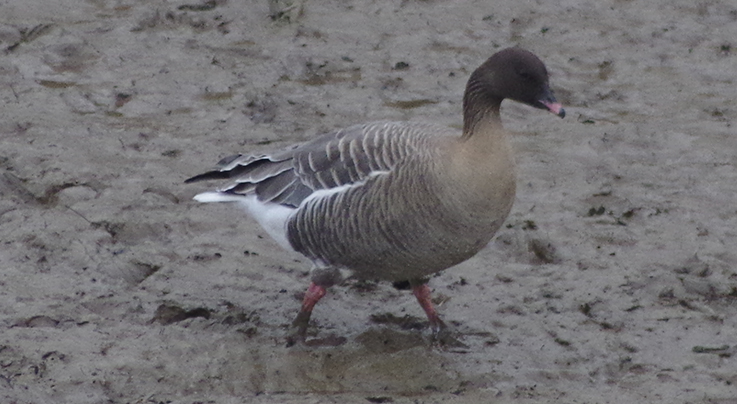 Pink Footed Goose Photo: © Andrew Nicholson
Pink Footed Goose Photo: © Andrew Nicholson
while in October, I found a Russian White Fronted Goose among the hundreds of Canada Geese on the Tresillian River. Both of these species are winter visitors to the UK from the far north, but are scarce visitors to Cornwall. The Pink Foot breeds in Iceland, Greenland and Svalbard, while the White Fronted Goose has two sub species, one that breeds in Greenland, the one that breeds in northern Russia. Single birds will often seek a larger goose flock to adopt it for safety, so it’s often worth trawling through a large flock of Canada’s to see if anything else is hiding within it.
Birds of prey have shown well this year in Tresillian. Back in May there was a major Red Kite influx to Cornwall during the VE day weekend. Hundreds of birds were seen moving through the county to the far west of Cornwall.
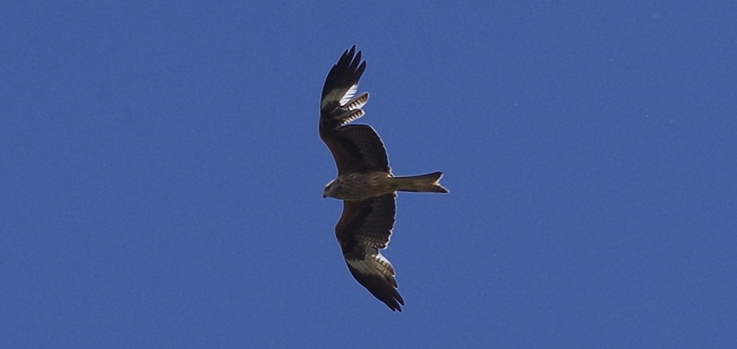 Red Kite Photo: © Andrew Nicholson
Red Kite Photo: © Andrew Nicholson
The Monday after saw a sharp dip in temperature and saw many of the birds returning back “up country”. To our good fortune, some of them decided to head back via the Tresillian valley and many people spotted them. I saw a total of 18 pass through during that afternoon – easily a single day record for Tresillian. Meanwhile an Osprey was a real highlight hunting on the river in September. Ospreys have been seen more often in recent years in September along the Tresillian River as they migrate to winter in Africa from their nesting areas in northern Britain. At least one bird was seen on and off during a three-week period through the month. To watch this mighty bird plunge into the water feet first and pull out a sizable fish, and powerfully rise out the water with its quarry clasped in its talons, is one of the great sights in nature.
We always have a decent number of Shelduck on the river through the winter months (around thirty), but most disperse late in the spring. In some years a pair decide to stay on and breed, and that’s what happened again this year. Initially 14 tiny ducklings were seen. They are able to swim as soon as they hatch, but are very vulnerable to predators or being swept away by the current. It was absorbing to watch them develop each week, and I’m glad to say four of the youngsters made it to adult independence and fledged in the summer. On the subject of ducks, a drake Pintail was a real surprise on Tresemple Pool in October. I found this bird just two minutes after finding the White Fronted Goose! A Pintail is a smart looking duck with chocolate coloured head, a yellow rump and a pronounced pointed tail. Not a common bird at all in Cornwall, this was the first I had seen along the Tresillian River for 25 years!
It’s been a very good autumn for Fircrest. These are beautiful, tiny little birds, the same size as the more common Goldcrest (with whom they sometimes mix with, and are Britain’s smallest birds), but with much bolder and brighter markings. A few nest in Britain, but most of the birds that turn up in autumn and winter are migrants from the continent. I’ve seen ones or twos in Tresillian before, but I’ve seen quite a few different sightings this autumn in the village and along by the river. One even turned up in a bush two feet away from our living room window!. A Yellow Browed Warbler was a really surprising garden visitor in late October and was seen around the garages at the top of Polsue Way that afternoon. Only marginally larger than a Firecrest, this species is an annual scarce visitor to the UK from northern Siberia. Most of these migrate to spend the winter in southern Asia, but a few each year head south westwards instead and end up in our country. Normally about a dozen might be reported in Cornwall each autumn/ winter. This year though there seems to be an increased number of sightings. and it’s very likely there’s been some kind of small influx with an amazing 25 individuals being seen by one observer on the Isles of Scilly in one day!
The quiet of the first lockdown gave an opportunity to hear birds in a way that is not normally possible. In the reed bed near the Audi garage, Reed Warblers could be heard calling, and could be glimpsed precariously clinging on to the reed tops. These birds are summer migrants and were nesting here. I’ve never seen or heard them in Tresillian before. It’s not clear whether they came because it was so much quieter than normal, or whether they have come in other years, but were only noticed this year because they could be heard as oppose to being drowned out by the traffic on the main road.
Kingfishers are always one of the star birds to look for along the river and have been very active of late. One or sometimes two can often be seen at Tresemple Pool, and another favoured site is near the waterfall on the footpath over the waterfall. Sometimes one can even be seen from the Texaco garage – it’s always worth looking out over the wall! This beautiful bird is often high on the bucket list for people to see, and it’s surprising just how many people have never seen one. If you’re patient and wait by somewhere like Tresemple Pool, you’re almost bound to see one eventually in you watch carefully. Listen out for a high- pitched trill and you will often see a flash of blue flying low over the water; hovering and diving for small fish, or perched in a tree by the pool.
As well as birds, there have been plenty of other highlights in the natural world to enjoy locally. Back in the spring I had several sightings of Fallow Deer. On one occasion there was a small group making its way along the edge of the far side of the river bank right opposite the village and another time I came face to face with one on the Pencalenick road whilst on my bike. There was a fantastic display of bluebells around by the obelisk in late April and May, while in June there were thousands upon thousands of foxgloves blazing in the clearing by between the obelisk and main road in Pencalenick woods, an amazing sight!
There have been many challenges this year and I’m sure some of these will last well into the New Year, but enjoying and experiencing the natural world around us is one thing that can help sustain us through difficult times.
Andrew Nicholson
November 2020 Keith Littlejohns, Birdlife at Tresemple Pond, next to Tresillian River.
CANADA GEESE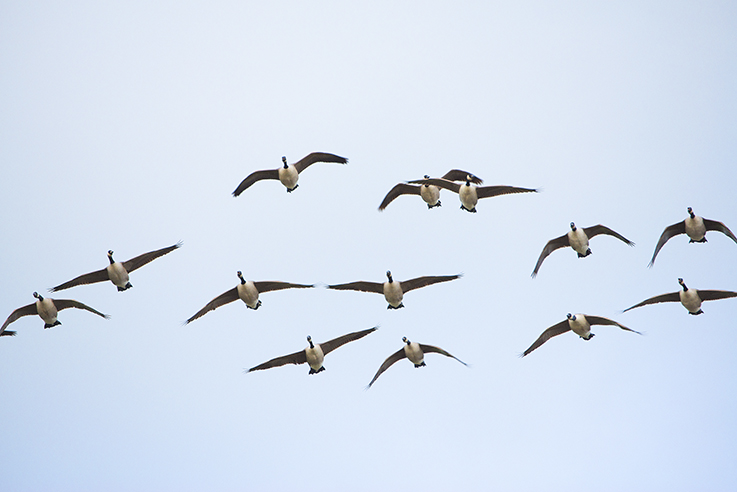 Majestic Canada Geese flying over Tresemple Pond by Tresillian River.
Majestic Canada Geese flying over Tresemple Pond by Tresillian River.
The Canada goose, Branta canadensis is the largest and most familiar goose seen in the UK. Commonly nesting on park lakes, flooded gravel pits and reservoirs and can be seen all year round. Canada geese are a non-native species, having been introduced from North America some 300 years ago to the UK in St. James’s Park, London, in the 17th century. Since then they have spread widely across the UK to most areas apart from the far north of Scotland.
The success of this common park species has led to its often being considered a pest species because of its excrement, its depredation of crops, its noise, its aggressive territorial behaviour towards both humans and other animals, and its habit of begging for food (caused by human hand feeding).
Canada geese are primarily herbivores, although they will sometimes eat small insects and fish. Diet mostly includes green vegetation and grains. The Canada goose eats a variety of grasses when on land.
Canada geese start breeding during their second year and remain monogamous. The female lays from two to nine eggs with an average of five, and both parents protect the nest while the eggs incubate, but the female spends more time at the nest than the male. Their nest is usually located in an elevated area near water such as streams, lakes, ponds. Eggs are laid in a shallow depression lined with plant material and down.
Adult: Length: 55-100cm , wingspan: 1.6m , weight: 4.6kg.
Average lifespan: 6 years. They are a protected species in the UK.
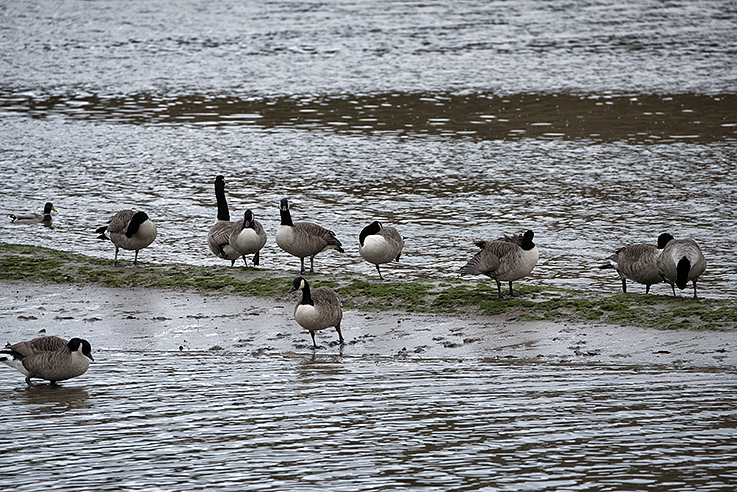 Canada Geese, Branta canadensis preening feathers on mudbank, Tresillian River.
Canada Geese, Branta canadensis preening feathers on mudbank, Tresillian River.
LITTLE EGRET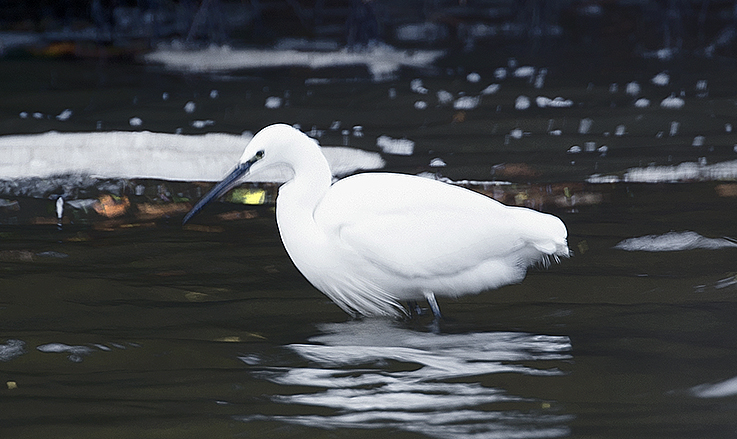 Little Egret at dusk on Tresemple Pond by Tresillian River looking for an evening takeaway.
Little Egret at dusk on Tresemple Pond by Tresillian River looking for an evening takeaway.
The Little Egret, Egretta garzetta is actually a small white member of the heron family. It first appeared in the UK in significant numbers in 1989 and first bred on Brownsea Island, Dorset in 1996. Its colonisation followed naturally from a range expansion into western and northern France in previous decades. It is now at home on numerous south coast sites, including our area of Cornwall, both as a breeding species and as a winter visitor.
Habitat: Lakes, marsh, flooded fields and estuary.
Length: 60cm, wingspan: 92cm, weight: 450g.
Average lifespan: 5 years.
Diet: Mainly aquatic insects, crustaceans, fish, amphibians, molluscs, reptiles, worms, spiders, and small birds. They feed alone or in small groups.
Little Egrets nests are placed on the ground or in reed beds, in trees up to 20 metres above the ground, or in bushes, always near water or on it. The nest-site may be situated in flooded areas or wooded islands, but also in marsh vegetation.
They breed from second year of life. Female lays 4 to 5 green-blue eggs and has one brood per season.
All Photos: © Keith Littlejohns
October 2020 Fred Taylor, Kingfisher, Wagtail and Heron Seen in Village.
Just a few of the pictures taken over the last couple of months. I bought some camouflage netting and have been able to watch the kingfishers feeding and preening themselves and they don’t feel threatened. I have spent hours watching them and managed to get over 2000 pictures since July.
Also photographed a grey wagtail that has been about for the last week or so. I also have an infrared camera that I leave out, I didn’t realise that Herons are moving around at ten o’clock at night.
Hope everyone is well and staying safe during the pandemic.
All Photos: © Fred Taylor
06-10-2020 Philip Buddell, Update on Swans in Village.
Some sad news this morning, with one of the 5 cygnets having died on the river at 9am. The bird had not taken food for two days and was acting differently earlier this morning, having paddled downstream for some distance on its own before the rest of the family caught up with it and ushered it back here; briefly it got out of the water on the opposite bank, but then joined the rest and swam over to ‘our’ side, where it laid its neck along its back, then gave two soft beats of its wings and passed away. We have now lifted the bird out of the water and put it in our dinghy, but will take it downstream later for a ceremonial departure. We cannot get hold of either the RSPB or RSPCA to see if they would have liked to conduct an autopsy, since both organisations are now only taking emergency calls.
The rest of the family all look fine and are eating as normal, but it’s a very sad day here after 5 months of daily caring for the family.
Philip Buddell
October – November 2020 Keith Littlejohns, Some More Common Wildlife Visitors to Our Garden and Other Wildlife.
All Photos: © Keith Littlejohns
BLACKCAP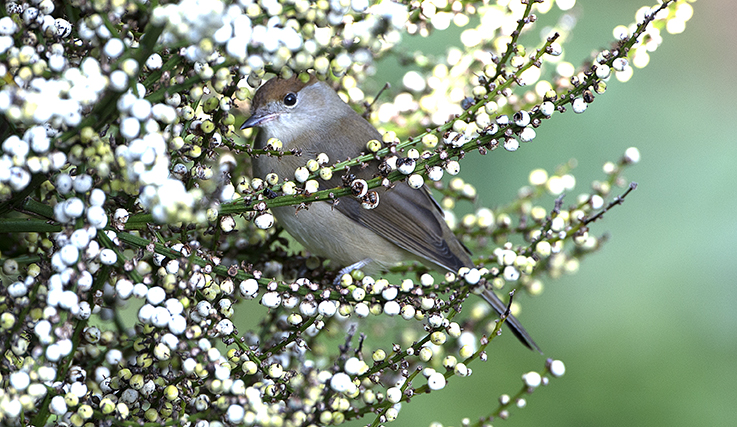
Adult female Blackcap, Sylvia atricapilla feeding on attractive white autumn berries from a summer flowering of two Cornish/Torbay palms, Cordyline australis in our back garden.
The Blackcap breeds in much of Europe, favouring deciduous woodland. The nest is a neat cup, built low in brambles or scrub, and the clutch is typically 4–6 mainly buff eggs, which hatch in about 11 days.
Insects are the main food in the breeding season, but, for the rest of the year, blackcaps survive primarily on small fruit. Garden birds also eat bread, fat and peanuts in winter.
Common field grasshopper, Chorthippus brunneus resting on a Restio multiflorus stem in our semi-tropical garden area.
The Common Field Grasshopper is seen throughout most of the UK and can be found in dry grassy areas, meadows, fields, parks, roadsides and even on waste land. Length, typically 15-25 mm. Colour varies; although predominantly brown some can be green, some grey and some are even a purplish colour.
During the summer female field grasshoppers lay a large egg pod containing approximately fifteen eggs, which she buries just below the surface of dry soil. The pod case keeps the eggs safe over winter until spring when the young nymphs hatch. Nymphs, shed their skins three to four times before eventually becoming fully grown adults.
Common Field Grasshoppers are herbivorous, feeding mainly on grasses. The species is winged, flies well and has been known to swarm.
Dunnock, also known as ‘hedge sparrow’, but are not actually a member of the sparrow family, Prunella modularis feeding on seed scraps that have fallen onto a weedy patch in our lawn from the bird feeding station above.
Dunnocks are small ground feeding birds that tend to be shy and are often seen hopping about in low vegetation and around the edges of lawns, feeding on small insects, worms and seeds. When two males meet, however, they become animated with territorial calling and wing-flicking. Their average lifespan is two years and they have a length of 14cm with a wingspan of 20cm, weighing in at just 21g.
Their distribution is widespread throughout the UK and can be seen all year round having a preference for deciduous woodland, hedgerows, scrubland, brambles and parks and gardens that contain plenty of plants for cover. Research has shown that Dunnocks have declined slightly in gardens. This is thought to be due to garden use changes including reduction in planting to ease maintenance and/or higher percentages of hard landscaping for decking and car parking or virtually lawn only gardens for play.
Dunnocks nest from April to July. Egg clutches contain around four to five bright blue eggs and they can have up to three broods in a season.
Hairy lichen (fruticose) ’Old man’s beard’, Usnea cornuta or Usnea ceratina, and the flat lichen (foliose), Parmotrema reticulatum together on a Silver Birch, Betula pendula branch in our back garden.
Lichen thrive best in areas of clean air, so are a good indicator of air quality. Usnea cornuta is common to SW England and Wales, rarer in other areas and is mostly seen on branches of trees. Parmotrema reticulatum is mostly common to southern English coastal counties from Cornwall to Kent, with the densest areas of occurrence being in the south west.
Lichens are actually fungi with a difference. They contain an alga, which can be the Green Algae [phylum Chlorophyta] or the Blue-Green Algae [phylum Cyanobacteria]. Therefore, the fungus and alga are a dual functioning organism working in tandem. The algae are photosynthetic and thereby fix the sun’s energy, so one can think of a lichen as a fungus with solar energy cells.
Adult Goldfinch, Carduelis carduelis on Silver Birch, Betula pendula branch in our back garden.
STICK INSECT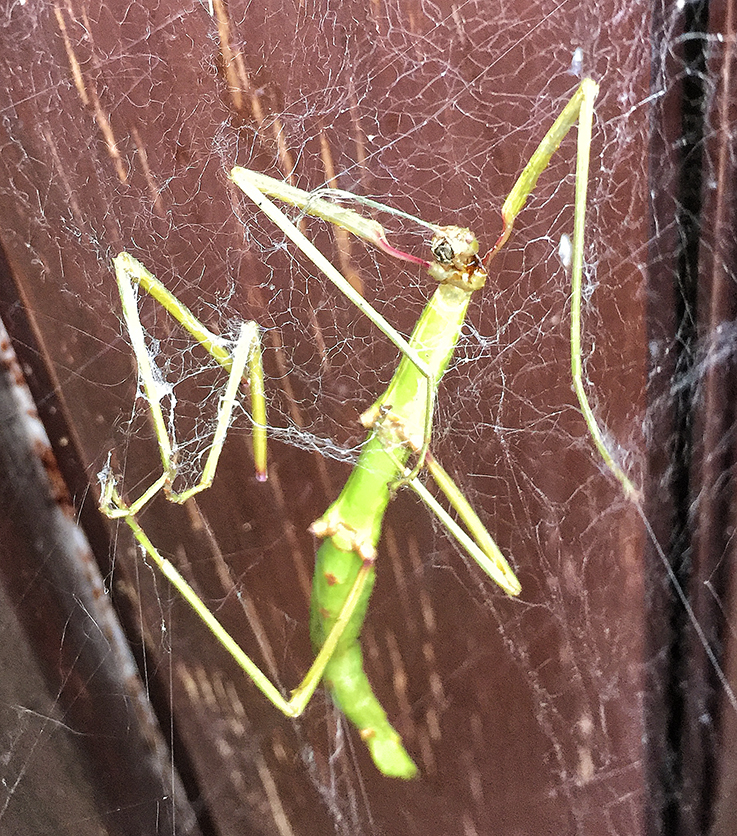 Deceased stick insect caught in cobweb on wood paneling in a corner of our courtyard. Noticed when tidying up plants in containers for the winter.
Deceased stick insect caught in cobweb on wood paneling in a corner of our courtyard. Noticed when tidying up plants in containers for the winter.
BLACKBIRD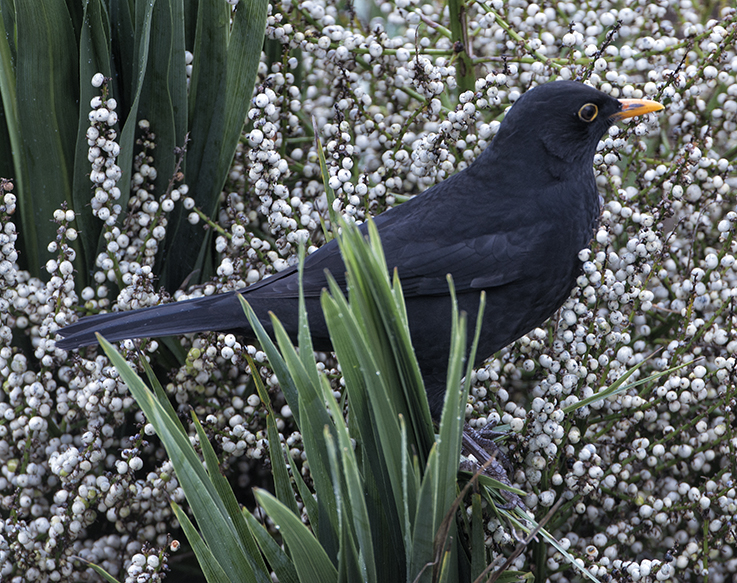 Blackbird, Turdus merula feasting on ripened, bright white cordyline berries from this year’s flowering in our back garden.
Blackbird, Turdus merula feasting on ripened, bright white cordyline berries from this year’s flowering in our back garden.
All Photos: © Keith Littlejohns
21-09-2020 Philip Buddell, Swans Seen in Village.
Thought you might like an up-to-date snap of the swan family, the cygnets now 4.5 months old, already flying, squabbling like any teenagers, and feasting on their morning supply of poultry grain following a loaf of wholemeal bread. This is the perfect way to start the day both for them and us – how privileged we are to have these magnificent birds at the end of our garden and to be able to enjoy their company in such otherwise depressing times.
10-09-2020 Keith Littlejohns, Some Common Visitors to Our Garden Bird Feeding Station.
All Photos: © Keith Littlejohns
GOLDFINCH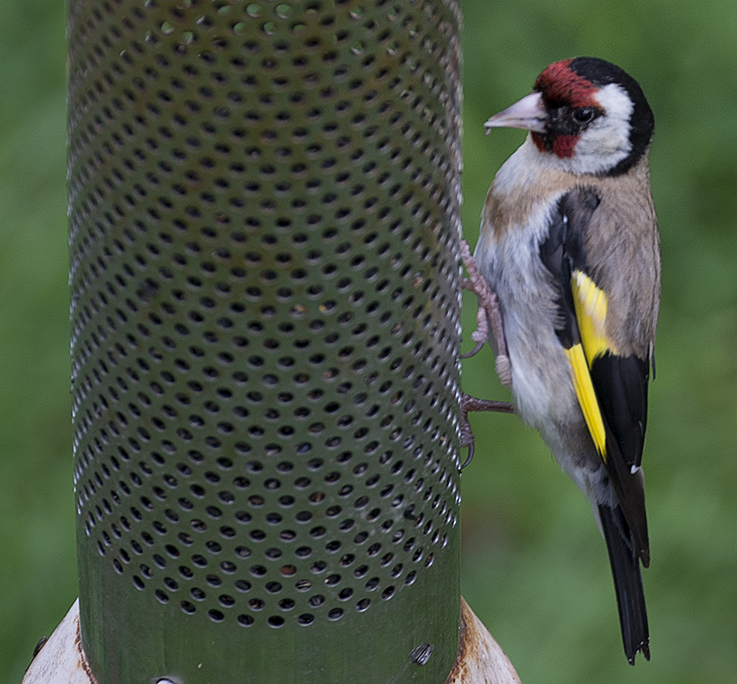 Adult Goldfinch, Carduelis carduelis, feeding on their favourite Nyjer seeds. These tiny, oil-rich, energy-giving black seed are highly nutritious.
Adult Goldfinch, Carduelis carduelis, feeding on their favourite Nyjer seeds. These tiny, oil-rich, energy-giving black seed are highly nutritious.
The seed of the African yellow daisy, Guizotia abyssinica, Nyjer is known by many names. The birdseed was originally called niger in reference to Nigeria and the plant’s geographic origin. The name was trademarked as Nyjer ® in 1998 by the Wild Bird Feeding Industry, however, to clarify proper pronunciation (NYE-jerr). Many birders also call it thistle seed, but Nyjer is not related to thistle plants, flowers, or seeds. It is believed that calling the seed thistle may have become popular because goldfinches, which adore Nyjer, also feed on thistle and use thistledown to construct their nests.
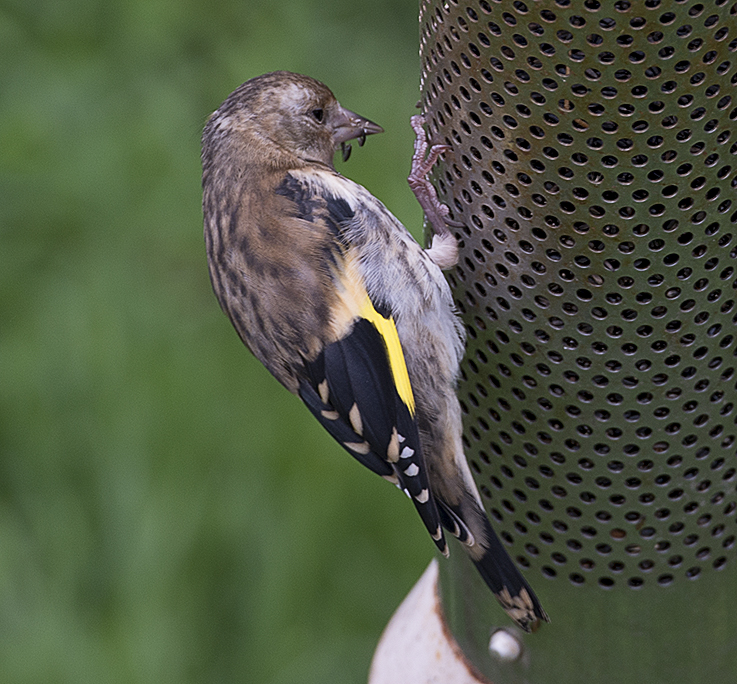 Juvenile Goldfinch, Carduelis carduelis, feeding on their favourite Nyjer seeds.
Juvenile Goldfinch, Carduelis carduelis, feeding on their favourite Nyjer seeds.
GREAT TIT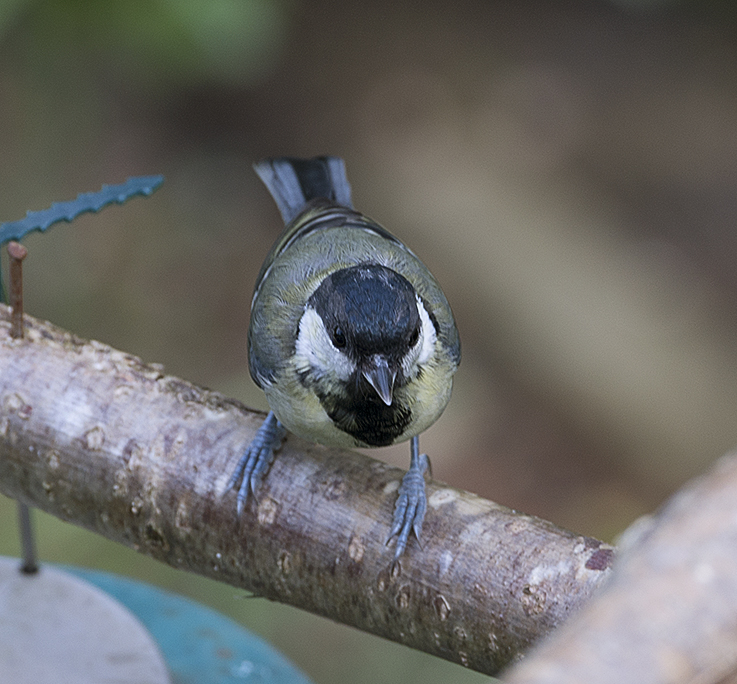 Adult Great Tit, Parus major, waiting patiently for a chance to feed.
Adult Great Tit, Parus major, waiting patiently for a chance to feed.
BLUE TIT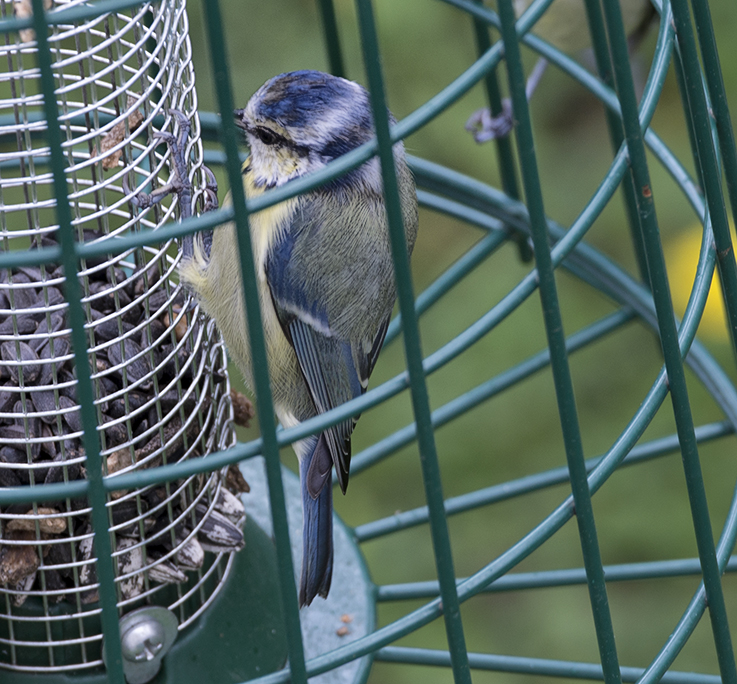 Female Blue Tit, Cyanistes caeruleus, feeding on sunflower seeds.
Female Blue Tit, Cyanistes caeruleus, feeding on sunflower seeds.
06-07-2020 Fred Taylor, Dippers and Kingfisher Seen in Village.
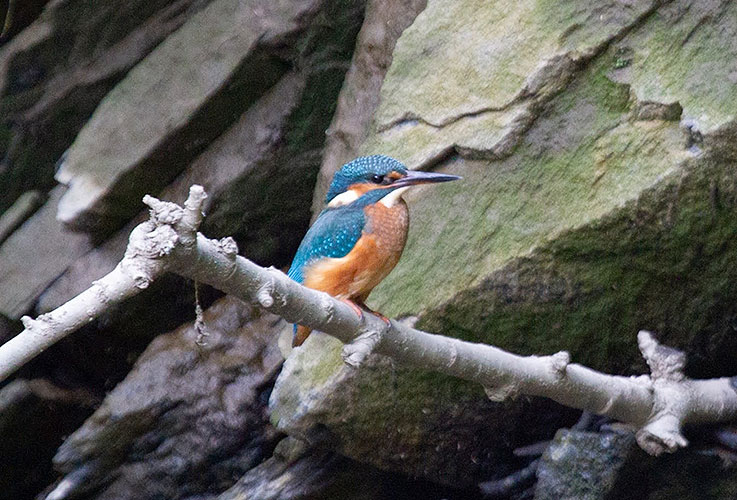
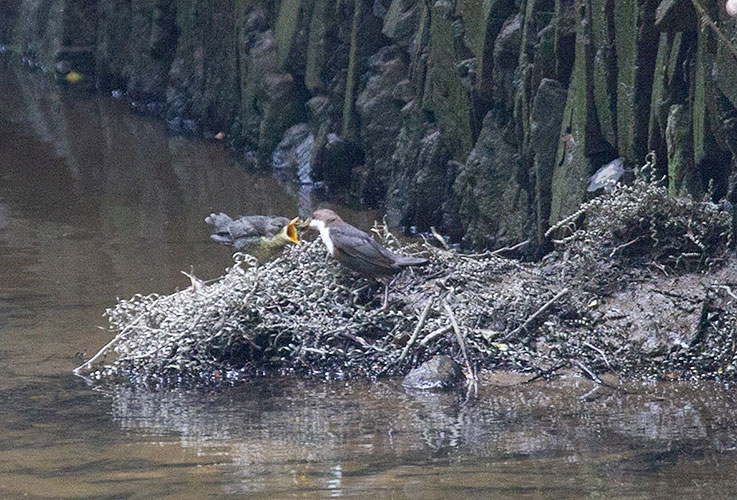 © All Photos: Fred Taylor
© All Photos: Fred Taylor
I took these this afternoon, the kingfisher looks like a juvenile female. I have seen 3 different kingfishers so far this year.
The dippers have been very busy feeding their young as you can see from these pictures. They are amazing parents
Best wishes – Fred Taylor
09-06-2020 Keith Littlejohns, Common Toad, Bufo bufo Seen in Village.
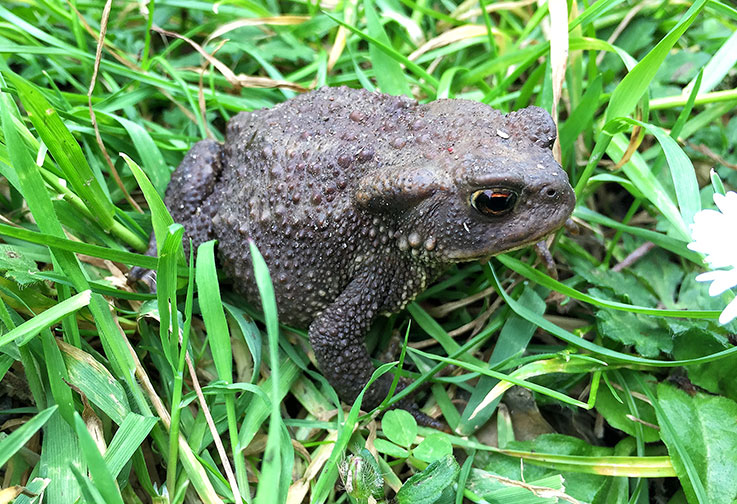 Photo: © Keith Littlejohns
Photo: © Keith Littlejohns
A common toad, Bufo bufo on a scrubby part of our lawn left un-mown to encourage daises, Bellis perennis and buttercups, Ranunculus spp. to grow. Common toads are frequently seen in our garden as there seems to be a sizeable community in our immediate vicinity.
They visit our pond and I have even found them in my wellington boots and gardening boots in our garage early in the year having hunkered down there for winter. The very first time I noticed this was whilst putting on one of my boots and feeling what I thought was an old sock stuck in the toe area only to be surprised to see a rather disgruntled toad looking at me through sleepy eyes. I now always check more carefully as this has happened on several occasions!
Common toads are amphibians, breeding in ponds during the spring and spending much of the rest of the year feeding in woodland, gardens, hedgerows and tussocky grassland. They are famous for their mass migrations back to their breeding ponds on the first warm, damp evenings of the year, often around St. Valentine’s Day.
Common toads tend to breed in larger, deeper ponds than common frogs, but still frequent gardens. They hibernate over winter, often under log piles, stones or even in old flower pots!
The common toad has olive-brown, warty skin, copper eyes and short back legs. It walks rather than hops, and lays its spawn in long strings around aquatic plants, with two rows of eggs per string.
Adult toad’s reach a length of 8-13cm, weigh up to 80g, have an average lifespan is up to 4 years and are generally active from February to October.
All toad’s are protected in the UK under the Wildlife and Countryside Act, 1981. Priority Species under the UK Post-2010 Biodiversity Framework.
Keith Littlejohns
03-06-2020 Fred Taylor, Another Family of Swans Seen in Village.
Did you see that there was another family of swans that had ventured up the river on Sunday? They had 8 cygnets who were younger than our resident cygnets.
It all kicked off after we had fed them, the 2 males got in to a vicious fight, obviously the resident male was not happy that another male and family were on his territory. He saw off the intruders and they went further up the river, we haven’t seen the new family since but I did manage to get some pictures of them.
There were feathers everywhere.
Best wishes – Fred Taylor
01-06-2020 Keith Littlejohns, Sphinx ligustri the Privet Hawk-Moth.
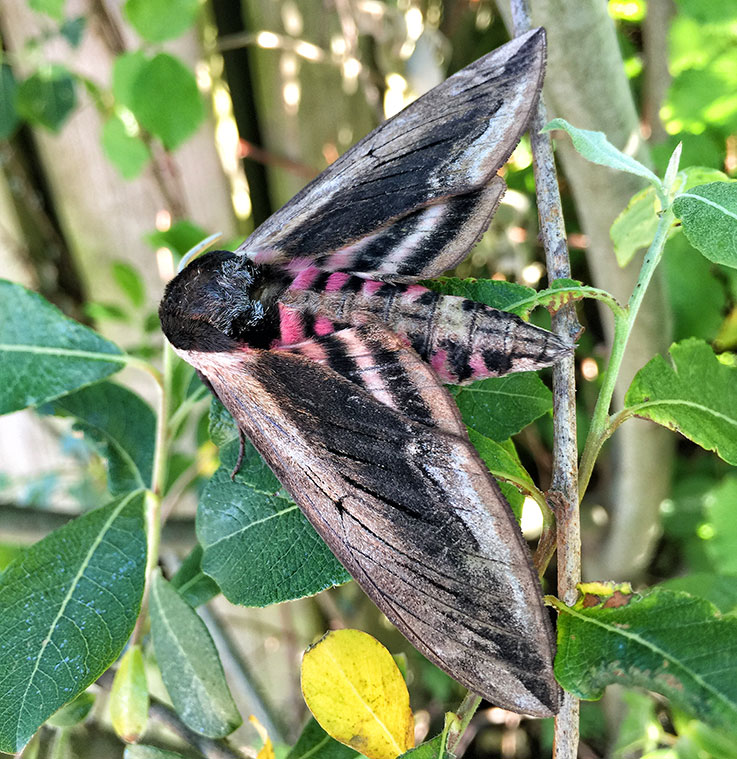 Photo: © Keith Littlejohns
Photo: © Keith Littlejohns
Photographed in shrubbery beside the Tresillian Allotment gate the distinctive delta shape and banded body colours of the large privet hawk-moth, Sphinx ligustri makes it easy to spot.
Privet hawk-moths are common across southern and central England and Wales. They are regular visitors to suburban parks and gardens as well as woodland, hedgerows and the wider countryside. These moths feed by night but can sometimes be found resting on tree trunks during the day. They typically have a 9-12cm wingspan, hence their common reference as large. Adults are on the wing between June and July. They are strong fliers and range widely in search of mates.
The UK’s population is stable and not thought to be under threat, however the rapid spread of ash dieback disease could impact the abundance of suitable caterpillar foodplants on which to lay eggs. You can encourage these moths to visit your garden by planting strong-scented night flowers.
Keith Littlejohns
17-05-2020 Philip Buddell, wildlife Seen in Village.
A few unusual happenings this week in the village: On Wednesday afternoon as Linda and I were returning by car from the Truro direction, the traffic (yes, it’s returned!) had halted towards the west end of the village near Creekside Close; a pair of Shelduck were fluttering over the grass verge above the river, and next thing we saw 8 ducklings rushing through the long grass trying to get down to the water. Where they had nested we don’t know, but it could have been somewhere on the other side of the road in view of the anxiety to get to the river.
This morning, Sunday, at 7.30am two young deer were in the river just up-stream from here, whether simply drinking or looking for fresh grazing we do not know, but another new siting close to home.
We’ve seen the kingfisher this week – unusual at this time when they are normally much further up-stream. Meanwhile the swans with their 5 cygnets are all happily swimming around up here, usually spending their nights on the opposite bank, and all seems well with their development after the loss of a single bird last weekend.
Best wishes – Philip Buddell
16-05-2020 Keith Littlejohns, Pieris rapae the Small White “Cabbage Butterfly”.
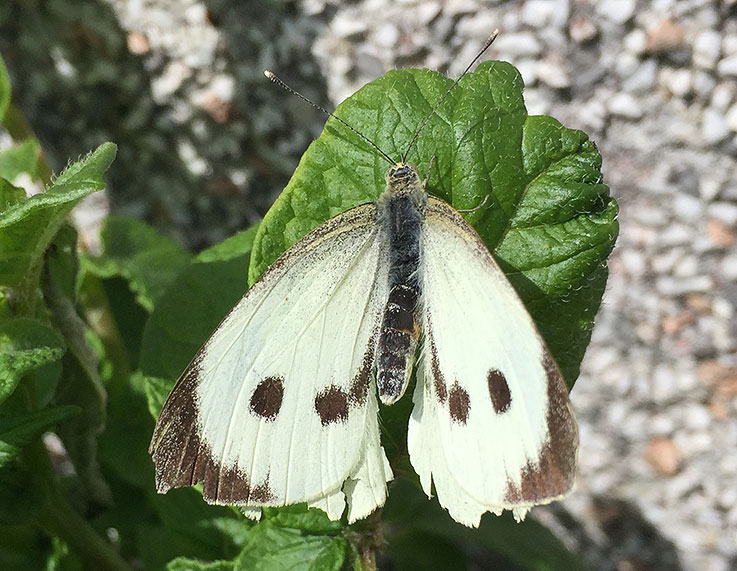 Photo: © Keith Littlejohns
Photo: © Keith Littlejohns
A rather worse for wear Small White, Pieris rapae butterfly settled on a potato plant leaf in our garden. The small white will readily lay eggs on both cultivated and wild members of the brassica (cabbage) family and the resulting caterpillars are voracious devourers of the leaves often resulting in ruined crops. For small growing areas of brassicas, such as a back garden or allotment plot, a practical solution is to securely cage the crop with what is known as butterfly netting before the butterflies are around to lay their eggs. Once all incidence of flying cabbage white’s is over for the season it is safe to remove the netting for use again next season.
Keith Littlejohns
15-05-2020 Fred Taylor, Wildlife Seen in Village.
I don’t know if Philip Buddell has told there is a pair of Moorhens up by us that have 3 chicks, I don’t think they venture very far from where we are. I have been trying to get pictures of them, I will send them to you if I can get some.
Did I tell you that there has been a couple of Dippers that nest under the bridge somewhere, they have had chicks, not sure how many. We see them start quite early in the year and again later in the year. Apparently, Dippers will use the same nest for generations, they are very busy up and down the river, they are also interesting to watch when they are looking for food. I will try to get pictures of them to pass on to you.
Best wishes – Fred Taylor
10-05-2020 Swan Family photo by Fred Taylor at ‘The Old Post Office’ cottage near the bridge.
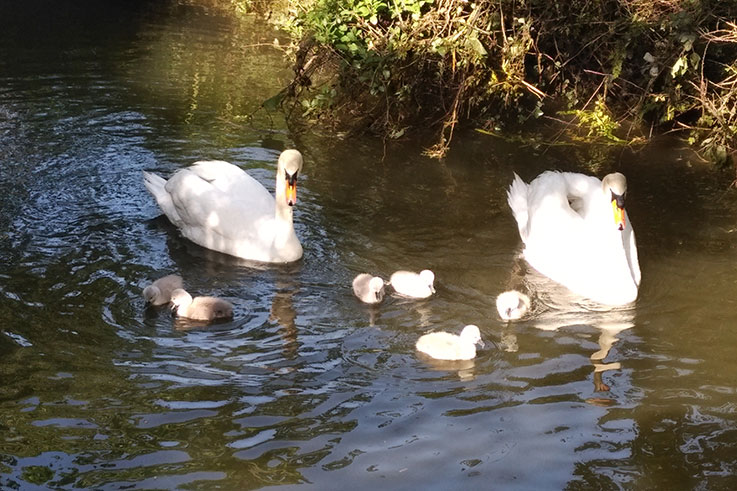 Photo: © Fred Taylor
Photo: © Fred Taylor
We had a visit from the swans and their family on the Tresillian River behind the Old Post Office yesterday and I thought you might like these for the website. They were taken on my phone, when they come back I will try to get some with my camera. Nice to see 6 of the 9 eggs are doing well and being looked after by mom and dad.
Best wishes – Fred
04-05-2020 Philip Buddell, Update on Swans in Village.
The good news is that 6 eggs have hatched as of this morning; we know there are at least two still in the nest, and the pen appears to still want to continue incubating. The 6 cygnets went on an adventure at 9 am today but ended up in a trench from which neither they could escape nor their parents rescue them. Linda managed to grab them one-by-one and return them to the surface, whereupon the young returned to the nest having had enough for one morning! The cygnets began hatching on Saturday, and we believe the 6th made it to the world yesterday afternoon. Meanwhile all is peaceful once again. More news as and when it happens.
Best wishes – Philip
02-05-2020 Philip Buddell, Wildlife Spotted in Village.
May 2nd is a great day for the river life of Tresillian. First this morning the resident house martins finally arrived along with a pair of swallows which haven’t resided here for the past 3 years. Already nest building is taking place. Then late this morning we noticed greater activity on the swans’ nest, and this afternoon we have so far counted 3 cygnets under the pen; she will continue sitting until all fertile eggs have been hatched which could take another 2/3 days. We will keep you informed and take some more photos when appropriate.
Best wishes – Philip
05-04-2020 Philip Buddell, First Swallow of Season Spotted in Village.
Yesterday, Saturday afternoon, 4th April, I saw the first swallow of the season flying up-stream past our home, no doubt on his/her way to points much farther north than Tresillian. Can’t recall having seen one of our African visitors here as early as this in the past, and he/she was no doubt carried along by the strong southerly winds emanating from North Africa and Spain.
Best regards – Philip
02-04-2020 Philip Buddell, Wildlife Spotted in Village.
We have seen a pink-footed goose wandering through with some 30 Canada geese during the past fortnight. Je’s a handsome bird with distinct markings including an orange stripe across his beak and of course the noticeable pink legs and feet! No doubt he will shortly move on to summer pastures in the tundra regions.
Swans are doing well, firmly entrenched on the 9 eggs.
Best wishes – Philip
29-03-2020 Keith Littlejohns, blackbirds nesting beside leat.
I discovered this blackbird, Turdus merula nest only yesterday, 29th March whilst working in our back garden. It is very well camouflaged in the lichen encrusted branches of an of an old damson tree on the opposite bank of the leat that runs along the bottom of our garden. The position is excellent being not only well hidden but also several feet above ground and hanging over the water below. Safe and secure enough from predatory large birds and prowling domestic moggies.
Blackbirds (males are black, females are brown) feed on insects and earthworms taken from the ground either by probing the ground, such as a lawn, and can often be seen having a tug of war with the odd earthworm from ours. They will also noisily turn over leaf litter with their bill foraging for worms and insects that take their gastronomic fancy. Our garden is on the edge of deciduous woodland, where many birds have an abundance of natural foods to choose from.
Cotoneaster berries and windfall fruits such as apples provide blackbirds with a valuable source of food come autumn. They also ground feed on fallen scraps under our bird feeding station.
Our native blackbirds are mostly resident all year round, with numbers in winter being swelled by their cousins migrating from Scandinavia and northern Europe.
Breeding usually starts in March. The smooth, glossy eggs are light greenish-blue with reddish-brown spots, and approximately 29 mm by 22 mm. The female incubates the eggs by herself. She can lay 2-3 clutches of 3-5 eggs. Incubation takes from 10-19 days. After the young hatch, they are fed by both parents.
The blackbird’s beautiful, mellow song is one of the loveliest of all songbirds and a delight to the ear.
I needed to use a long lens because the best, and least disturbing for the birds, vantage point was some 12m-15m away. Although I think this male blackbird had his sharp beady eye firmly fixed on me.
Hope you enjoyed the photo and information – Keith
29-03-2020 Philip Buddell, swans nesting on Tresillian River bank.
While the pen was having a feed at the foot of our slipway yesterday, Sunday, afternoon, I made a brief trip to the nest where she has started incubating and counted 9 eggs, so a good clutch this year which we will do all we can to help them be successful. It will be some 6 weeks before we see any cygnets.
I do hope your followers will enjoy this continuing story. More will follow as the incubation proceeds.
Best wishes – Philip
25-03-2020 Philip Buddell, swans nesting on Tresillian River bank.
Amidst all the depression of the news and coronavirus, it is heartwarming to find nature still giving us enormous pleasure and so much for which to be thankful!
Opposite our home the swans, Elizabeth and Philip, the queen and her consort, have taken up residence by a hedge at the back of the riverside meadow, where Linda and I have provided them with two small hay bales and more recently a half bale of straw with which to build their nest. There was previously a decided lack of nesting material, though for once the site they have chosen will be above spring high tide levels and there is every chance on success with incubation. Presently the queen is still laying her eggs. I counted six 3 days ago, and I feel sure more have since been laid though I do not want to disturb her to find the current number. I’ll discover more with discrete site visits during the coming days. The pen really does look like a queen on her throne, hence we thought Elizabeth and Philip most appropriate!
I do hope your followers will enjoy this snap. More will follow as the incubation proceeds.
Best wishes – Philip
29-01-2020 Some lovely photos by Fred Taylor at ‘The Old Post Office’ cottage near the bridge. Taken over the last few years.
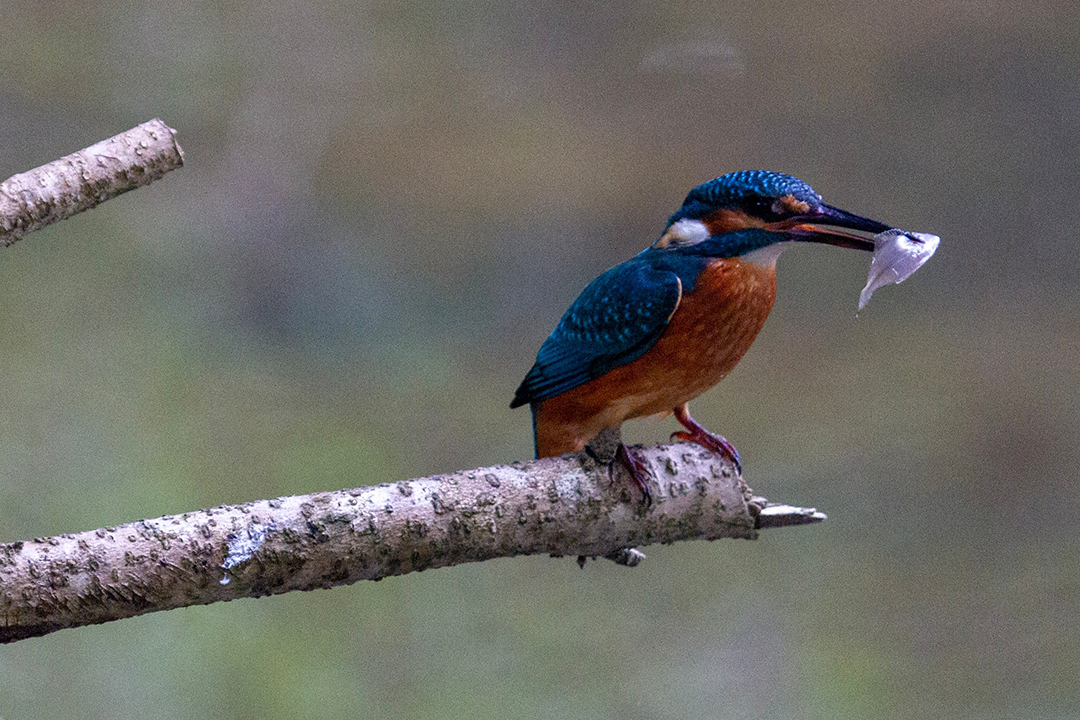 Kingfisher, Tresillian River taken from cottage garden.
Kingfisher, Tresillian River taken from cottage garden.
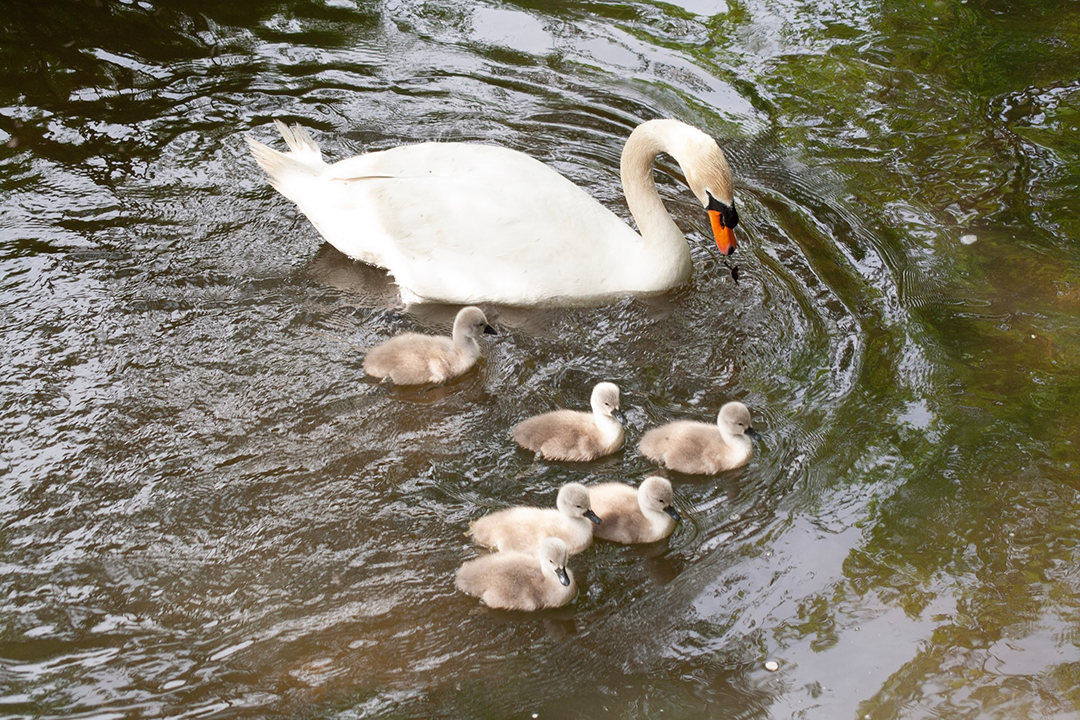 Swan and cygnets, Tresillian River taken from cottage garden.
Swan and cygnets, Tresillian River taken from cottage garden.
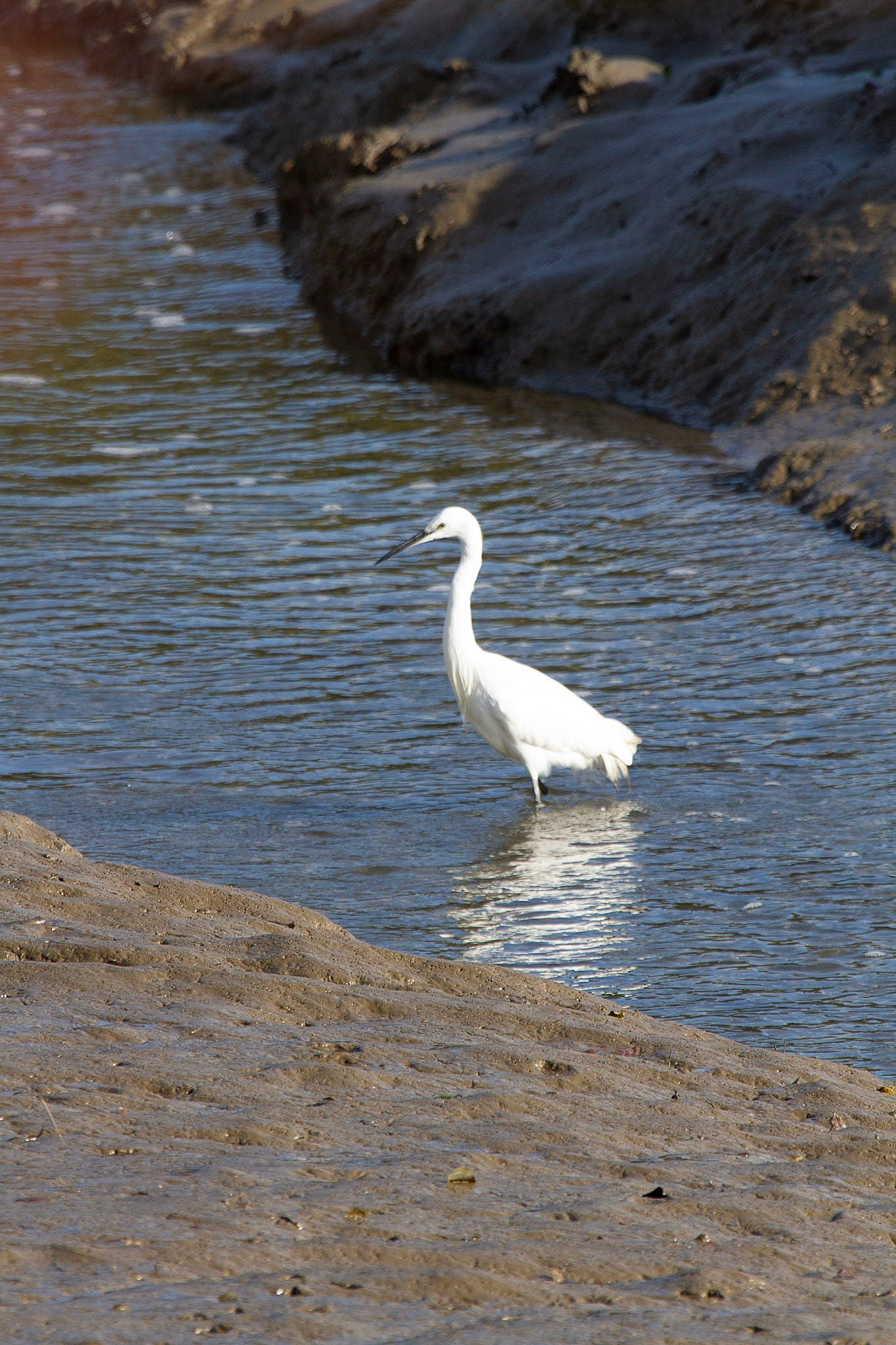 Egret, tidal Tresillian River.
Egret, tidal Tresillian River.
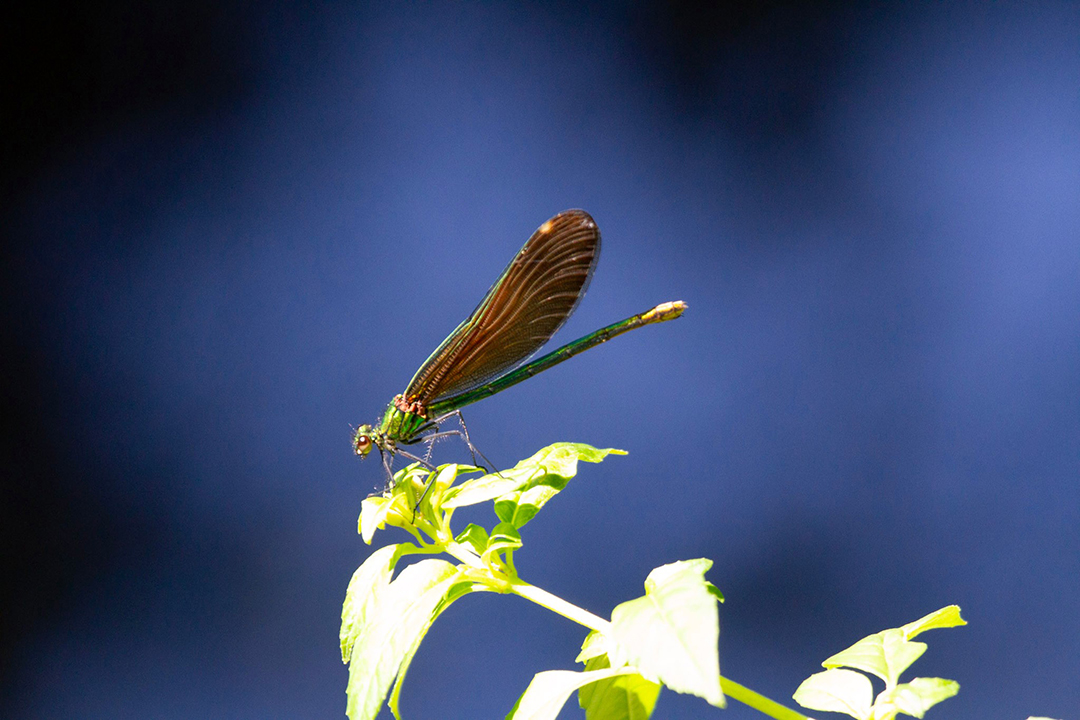 Damselfly, Tresillian River taken from cottage garden.
Damselfly, Tresillian River taken from cottage garden.
All Photos: © Fred Taylor
